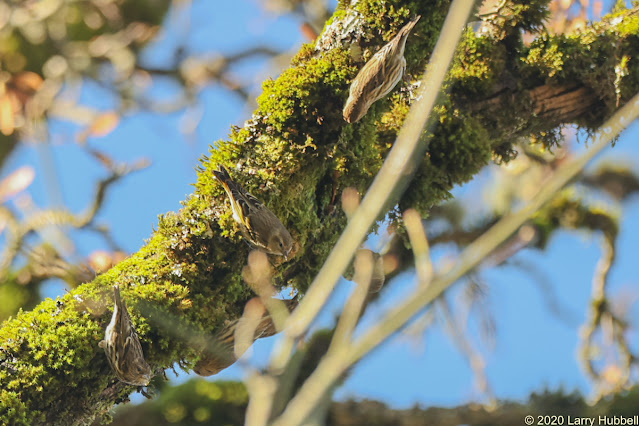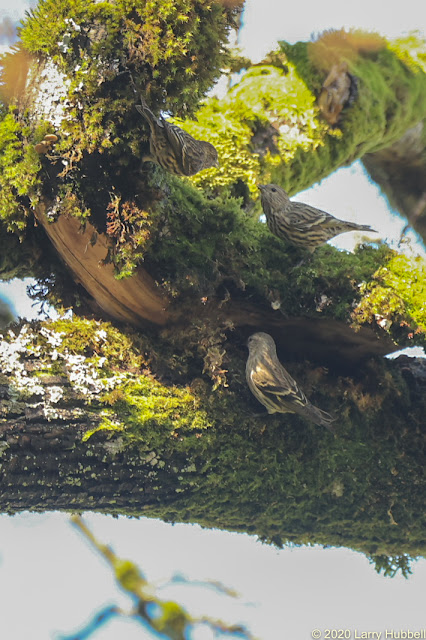On Friday, while walking near Arboretum Drive, it was hard to miss this Tuliptree all dressed up in its finest fall foliage. It was so attractive everyone turned their backs on the Bigleaf Maple trees on the other side of the pedestrian-only street.
The Maples had already dropped their leaves. At first glance, there was nothing particularly memorable or attractive about them.
Tulip trees are part of the Magnolia family. They come from the southeast part of the United States. I was confused. I had expected that a tree from a warmer climate would drop its leaves earlier than a northwest native like a Bigleaf Maple.
It turns out that Tulip Trees are quite robust. They can grow in the heat of southern Florida while also thriving all the way north into the province of Ontario. I guess I wasn't totally wrong. It is a tree of the southeast, at least from a Canadian perspective.
Without leaves obstructing the view there was suddenly more to see in the Bigleaf Maples. Initially, I noticed just a few small fluttering birds, high overhead, searching the moss-covered branches for food. They were often hidden in the shadows. A closer look revealed there were dozens of them! (I can see five in this photo.)
The notched tail, on the bird in the middle, indicates they are members of the Finch family. In the same way that an American Robin is a Thrush, the common name for this bird does not include the word, Finch.
This type of finch sometimes has yellow along the wings and tail. At the distance involved, I was lucky to catch this quick flash of yellow from under the tail.
Another important piece of identifying information was their relatively delicate pointed bills.
Unlike this female House Finch, the birds we are trying to identify do not have a heavy-duty, seed-cracking beak. However, they do share somewhat similar grayish-brown stripes.
Another finch, which we occasionally see in the Winter, who also has a delicate bill is the Common Redpoll. However, the birds in the Bigleaf Maple did not have red caps or black face masks.
That only leaves one likely local candidate. I believe these were Pine Siskins.
Even from the ground is was fun to watch them flitting around. I suspect there were at least fifty, if not more. I would have liked hearing them but with the distance involved, they were beyond my range. Click Here and listen to the third recording to hear their most distinctive call,
Suddenly, about half of the Siskins leaped into the air. Like a small cloud with a mind of its own, they evacuated the area.

A moment later this male, Pileated Woodpecker landed in the Bigleaf Maple tree. As far as I know, Pileated Woodpeckers are not known to prey on smaller birds. Still, I suspect its size was intimidating. When you are a small bird it is probably safer to fly at the first sign of danger. Waiting around to access the situation could be fatal.
The woodpecker worked his way around searching some of the same places where the Siskins had been. However, he came equipped with a much longer tongue, which enabled him to investigate the subsurface dwellings of carpenter ants and their larva.
Earlier, I was surprised to see the following sequence. Given that summer has passed and most young birds have already learned to feed themselves.
It looks like the bird on the right is coming closer to feed the bird on the left, even though I cannot see any food.
I cannot think of any other explanation. This certainly looks like feeding behavior to me. Pine Siskins are reported to sometimes have two broods in the same year, so I wonder if this could be one of the last young from a second brood. Maybe this is one of the last signs of summer for 2020.
Note: Even seed-eating birds, like Pine Siskins, feed insects to their young.
When deciduous trees drop their leaves, at first glance, they may seem rather boring. Actually, without their leaves, a variety of avian activity can suddenly come into view. One might even call it a big reveal.
In Other News:
Bald Eagles:
Saturday was a windy day. The trees continued to lose their leaves and eagles, ravens and hawks enjoyed the extra boost from the wind beneath their wings.
Common Ravens:
Earlier in the week, I followed the sound of ravens and crows until I could actually see a pair of ravens moving through the treetops in the Arboretum. As they flew away, from the crow harassment, I was surprised to see a third raven following along. Apparently, at least one of the young from this year's nest must be still hanging around the parents. It is also possible that what I saw was both of the young following after one of the adults. They all appeared to be the same size so it is only their behavior (and number) that makes me think one or more must be first-year birds. I have read that sometimes a young one will even hang around until the next Spring and help out with the next year's nesting process.
American Bitterns:
Last week, based on the range maps in All About Birds (and Birds of the World) I assumed that American Bitterns no longer nested to the west of the Cascades. Several readers pointed out information to the contrary. I was glad to learn there are year-round sightings on Whidbey Island, Spring sightings at the Ridgefield Wildlife Refuge and via Birdweb (by connecting through to the Sound to Sage Breeding Bird Survey) I learned of one confirmed nesting location in King County and many other possible and probable locations. Go Bitterns!
Wildflowers:
I also received this very handy plasticized wildflower pocket guide this week. It was compiled locally by our neighbor Jane Lundin. 265 flowers are sorted by color and surprisingly identified by common, scientific, and family names. It also contains a relative guide to each flower's size, as compared to the photo. That is a lot of critical information in a small package that looks quite handy, and light, for backpacking in the mountains next Spring. It is titled, Mountain Wildflowers of Washington.
Have a great day on Union Bay...where nature lives in the city and Black Birders are welcome!
Larry
Going Native:
Without a well-funded Environmental Protection Agency, it falls to each of us to be ever more vigilant in protecting our local environments. Native plants and trees encourage the largest diversity of lifeforms because of their long intertwined history with our local environment and native creatures. I have been told that even the microbes in the soil are native to each local landscape. I hope we can inspire ourselves, our neighbors, and local businesses to respect native flora and to support native wildlife at every opportunity. I have learned that our most logical approach to native trees and plants (in order of priority) should be to:
1) Learn and leave established native flora undisturbed.
2) Remove invasive species and then wait to see if native plants begin to grow without assistance. (If natives plants start on their own, then these plants or trees are likely the most appropriate flora for the habitat.)
3) Scatter seeds from nearby native plants in a similar habitat.
4) If you feel you must add a new plant then select a native plant while considering how the plant fits with the specific habitat and understanding the plant's logical place in the normal succession of native plants.
My intention in my weekly post is to include at least one photo each week and visually challenge us to know the difference between native and non-native lifeforms.
(By the way, my friend Tom Brown pointed out that the application named 'Wildflower Search' is extremely helpful. Click on the highlighted link to see for yourself.
(By the way, my friend Tom Brown pointed out that the application named 'Wildflower Search' is extremely helpful. Click on the highlighted link to see for yourself.
Also, Jane Lundin has created a small package, with a lot of critical information that looks quite handy, and light, for backpacking in the mountains in Springtime. It is titled, Mountain Wildflowers of Washington.)
Scroll down for the answer.
***************
American Goldfinch: Yes. Not only are they native to the PNW the American Goldfinch is our state bird. Even though we call it the Willow Goldfinch, it is still the same bird.
***************
The Email Challenge:
Over the years I have had many readers tell me that Google is no longer sending them email announcements regarding my posts. Even more frustrating when they go to 're-sign-up', hoping that will enable them to once again start receiving the announcements, they get a message which says 'Sorry, you are already signed up.' Google has not responded to my requests for help with this issue.
My functional workaround is to set up my own email list and each week I manually send out a new post announcement. If you are experiencing the issue and would like to be added to my personal email list please send me an email requesting to be added. Thank you for your patience!
My email address is: LDHubbell@Comcast.Net
One more photo for the persistent:





















No comments:
Post a Comment